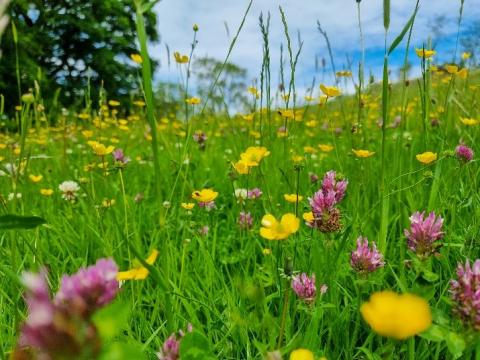24 January 2022
Dr William Stiles: IBERS, Aberystwyth University.
Take home messages:
- Current rates of climate and environmental change present numerous challenges for food production systems.
- Ecosystems that are in a degraded state will be more susceptible to perturbation from climate and environmental change.
- Building resilience into the ecosystems we rely on for food production is essential to ensure the continued potential for food production.
- Increasing biodiversity has been shown to deliver biodiversity related ecosystem services, such as soil fertility, pollination, and natural pest control, which can enhance the potential for production.
As a result of the push for increased food production, through intensified agricultural approaches, modern agriculture has had an adverse impact on farmland biodiversity. This has occurred as a consequence of multiple factors which include the loss of habitat and habitat connectivity, and through the process of landscape simplification, where field systems dominated by single species have been actively promoted.
Increasingly the benefits of associated wildlife and biodiversity have been recognised, and in more recent years strategies have been implemented to enhance farmland biodiversity levels. Nevertheless, the agroecosystem, which is historically biologically diverse due to the multiple environment and habitat types found on a traditional farm, remains impoverished.
This fact presents an increasingly pressing problem for the vitality of farmland environments in the future, as ecosystems which have low biodiversity will have low potential resilience, making them more susceptible to the impacts of environmental change. In ecological terms, environments which are healthy and functioning will be more resilient, and therefore more able to absorb the influence of environmental change.
The agro-ecosystem is diverse and supports numerous different habitats and environments. As a society we rely on the agro-ecosystem for the necessary production of food. However, current food production practices can have adverse effects on the agroecosystem, limiting the potential for function and thus reducing ecosystem resilience. In this context, where future environmental change affects how these ecosystems function, then this could have direct effects on our potential to produce food, with significant implications for future UK food security.
Current rates of climate and environmental change will present numerous challenges for UK ecosystems. For the ecosystem functions on which human populations rely, such as the potential for food production, implementing management that aims to increase the resilience of ecosystems is likely to become an essential objective to ensure continued UK food security.
Ecosystem function and resilience
Current and future environmental change, driven by anthropogenic activities, has the potential to adversely impact the health and function of numerous terrestrial and aquatic ecosystems. This is particularly true for agricultural systems, where biodiversity loss is already a recognised issue. The impacts associated with climate change are varied but include factors such as changing heat and rainfall patterns, increased frequency of extreme weather events, and altered or increased pest and pathogen incidence. These factors are expected to adversely influence the potential for agricultural production.
Increasingly it is recognised that reducing some of this impact is possible by managing the landscapes and ecosystems, within the wider agroecosystem, in a way that allows these systems to adapt to or mitigate against the effects of climate and environmental change. Such management focuses on restoring natural ecosystem function, and promoting agricultural practices that work with natural system characteristics, rather than fighting against natural processes.
Chief amongst these approaches is the restoration of agroecosystem biodiversity. Ecosystem stability or resilience is greater in systems with higher levels of biodiversity, as this relates directly to greater functional diversity, which allows communities to absorb the impact of disturbance on ecosystem function. In diverse plant communities, individual, and differing characteristics play a large part in governing the potential resilience of that system to environmental change. Functional diversity buffers a system against individual species decline, as the presence of more than one species with similar functional characteristics, can compensate for individual species loss, and therefore avoid overall functional loss.
High diversity of species allows for niche partitioning and complementarity in resource usage. For instance, in grassland systems, differences in below-ground plant structure and root distributions can have positive effects in terms of productivity, as different rooting strategies can allow plants to target resources such as water and nutrients from different layers of the soil profile, and crucially, from deeper layers, as increasing grassland species richness results in a greater proportion of species which have deeper rooting tendency.
Additionally, greater biodiversity and species richness in one group, can improve the species richness in associated groups, with reciprocal benefits for the plant community. The diversity of soil organisms has been observed to be significantly greater along a gradient of increasing grassland plant species richness, which is driven by increased diversity of food resource input into below-ground communities. Greater diversity of soil organisms relates directly to increased soil health and function, with improved potential for factors such as soil fertility. Thus, enhancing the biodiversity in below-ground systems will improve the overall potential for production and resource provision.
Ecosystem services in agriculture
Ensuring continued ecosystem health and function by promoting systems which have high resilience will also support the continued delivery of a wide range of ecosystem services on which human populations rely. Restoring or promoting biodiversity in agricultural systems can also reduce the need for external inputs by enhancing the delivery of ecosystem services, which can have beneficial effects on overall potential for production and therefore business efficiency.
This has been demonstrated for grassland systems, where increasing the species-richness in grassland has been shown to deliver biodiversity related ecosystem services, such as soil fertility, pollination, and natural pest control and management. Accordingly, improving these ecosystem services improved the overall potential system output. For example, the diversity of mycorrhizal fungi has been show to improve with increasing plant species richness in grassland, and an increase in the species diversity of mycorrhizal fungi has been shown to increase above-ground biomass production by more than 50%. So where mycorrhizal fungi diversity is higher, production potential will also improve. This phenomena occurs for a range of reasons, but a key factor is increased phosphorus (P) use efficiency, where increased biodiversity fosters better exploitation of P resources. This also has the added benefit of future-proofing farming systems against likely future declines in P fertiliser availabilities.
Perhaps the most important factor is to recognise that adopting such approaches will not come at the expense of food production potential, as has been suggested historically. In fact, improving biodiversity through approaches such as increasing grassland species richness, has actually been shown to increase overall biomass yield. This outcome is also the result of multiple system-based factors positively interacting, including those mentioned above, but significantly, is an effect of sufficient magnitude to result in comparable biomass yield between low fertiliser input species rich grasslands, and high management input monocultural swards. This indicates a potential management approach where utilising the characteristics of biodiverse grasslands could offset the need for fertiliser input, which could offer an approach to simultaneously reduce environmental pollution and the cost of food production, all whilst increasing ecosystem resilience and the potential stability of future food production.
Summary
Farm and food production systems of the future face a broad array of challenges from climate and environmental change, and from the necessary reduction in environmental impact from agricultural activities that contribute to climate and environmental change. In order to maintain food production in increasing variable climatic conditions, increasing ecosystem resilience will be essential to ensure the impact of disturbance from factors such as extreme weather, or pest and pathogen outbreaks, can be absorbed by systems with sufficient functional diversity.
A key approach to ensure ecosystems are resilient and able to maintain function is to increase the biodiversity of systems which have been simplified, or where monocultural cropping strategies have been promoted. For Wales, the primary approach must centre on increasing species richness in grassland, as this is the largest agricultural environment type. This has the potential to increase biodiversity nationwide exponentially, whilst still maintaining food production.
This action will improve the biodiversity of the grassland systems directly, and the biodiversity of associated systems, such as the soil, consequently. Additionally, such a management intervention will also improve the potential for production more generally, by reducing the need for inputs such as fertiliser or pest control agents, and by improving soil fertility and the potential for plant growth. Enhancing biodiversity and the potential for ecosystem resilience and ecosystem service provision is therefore an essential strategy, which will also benefit farmers by improving farm production potential.
If you would like a PDF version of the article, please contact heledd.george@menterabusnes.co.uk



